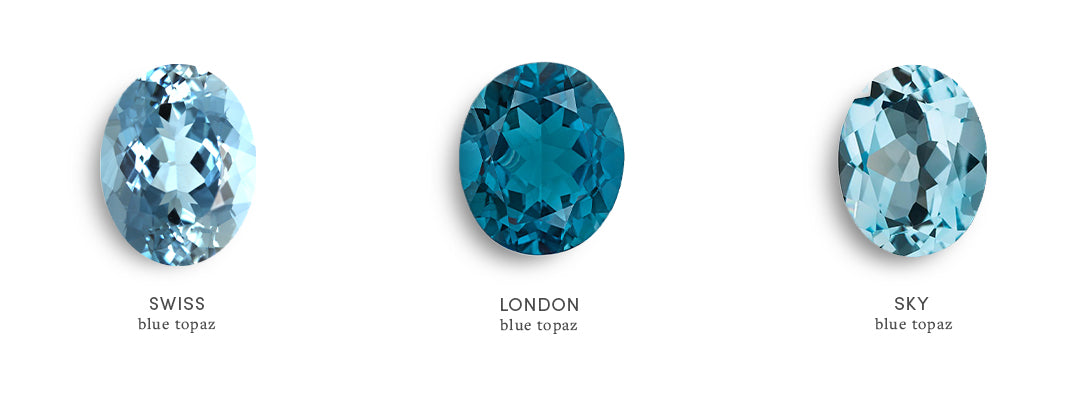Topaz Origin and Formation
The official birthstone for November, Topaz is a popular gem that is thought to symbolize affection and love.
TABLE OF CONTENTS
Topaz Chemical Composition & Formation
A rare silicate mineral with a chemical composition of Al2SiO4(F,OH)2. Topaz is usually formed in the cavities and crevices of rhyolite, pegmatite, and other igneous rocks. The gemstone is mined from numerous places all over the world and natural stones display a golden brown or yellowish color.
Topaz Colors
You will find other colors of topaz, including red, gray. orange, green, blue (we will look at blue topaz in more detail later on), pink and purple. These colors are created either by impurities or by man-made treatments carried out to transform the hue of the natural gemstone.
Natural Topaz Origin
When explorers discovered a precious stone on the small Greek island of Topazios they decided to call it topaz, however, the gem actually turned out to be another precious stone - peridot. Despite the confusion, the name stayed!
First Discovery of Topaz
The first yellow crystals (modern-day topaz stones) were discovered in Germany in 1737, and then in 1740, a large gem was found in Brazil. However, it seems that mix-ups seem to go hand-in-hand with topaz.
The huge stone was originally believed to be a diamond and was quickly fixed in place on the Portuguese crown. The gem was later identified as a topaz rather than a diamond - but kept its place on the royal headwear regardless.
Modern-day Topaz Mining Deposits
Nowadays, topaz can be found in a number of places around the globe, including Pakistan, Afghanistan, Japan, Mexico, Madagascar, Burma, Australia, and the USA. Huge topaz crystals have been found in the past in Ukraine and Brazil.
London Blue Topaz
For now, let's take a closer look at blue topaz. You will find a variety of blue topaz available, including Swiss Blue Topaz, London Blue Topaz, and Sky-Blue Topaz. Whilst natural blue topaz does exist, it is extremely rare. More often than not, blue topaz is man-made via treatments.

London Blue Topaz Meaning
London Blue Topaz is believed to signify healing and calming. This could be the perfect gem to say sorry or prove how much you care for someone. London Blue Topaz is also considered to be a precious stone that signifies affection and tenderness, so it could be the ideal gemstone if you're looking for a pretty London Blue topaz engagement ring.
How is Lab Blue Topaz Made?
Blue topaz is created from colorless or very lightly colored topaz. The topaz is irradiated and heat-treated to bring out the blue color. Experts apply different levels of radiation to create various shades of blue.
Popular London Blue Topaz Jewelry
Nowadays topaz is a very popular gem that comes in a variety of colors including red, pink, yellow, orange, blue, and green. Notably, topaz is known for its rich blue hue. Moreover, for being the birthstone for the month of December. Additionally, this gem is a great choice for a variety of jewelry. With it being one of the hardest gemstones, it can go through more daily wear. Customers can pick up an attractive:
- London Blue Topaz ring
- London Blue Topaz earrings
- London Blue Topaz bracelet
- London Blue Topaz necklace
The deep grey-blue color really stands out and proves to be very eye-catching. Jewelers set the gem in a variety of settings, if you're in the market for a ring we suggest you to look at our most popular styles.
How is Topaz Valued?
The value of topaz has fluctuated over the years. The gem is valued based upon a number of factors. The color of the gem plays a large part in calculating how much the topaz is worth. Rare pink and red stones are considered to be high in value, closely followed by orange and yellow.
Orange and brown stones are often considered to be more common. Of the blue topaz family, London Blue Topaz is thought to be the most valuable and desirable. The London Blue has a deep blue hue with a touch of green or gray glinting through.
Factors of Topaz Value: Clarity, Cut and Carat
Clarity, cut and carat also play their part. As is often the case with precious stones, “eye-clean” gems are considered to be more desirable. That said, inclusions don't always detract from the overall attractiveness of the gem.
Cut-wise, topaz is usually cut in an elongated fashion, with the cushion cut and elongated oval cuts are common (emerald cut London Blue Topaz rings are a popular choice too).
The carat of the gem equates to its weight - the heavier (bigger) the carat, the more expensive the price tag. However, for gemstones the price tag does not exponentially change with carat weight as it would with diamonds.
FAQs
What color is topaz?
How is topaz formed?
Is topaz lab created or naturally formed in the earth?
What are the colors topaz can be formed in?









